In an age dominated by digital technology, the allure of the classic “film look” continues to captivate filmmakers and audiences alike. Despite the widespread adoption of digital cameras and advanced visual effects, many modern movies deliberately seek to recreate the nostalgic aesthetic of traditional film. From the warm tones and subtle grain of celluloid to the distinctive texture and dynamic range of analog formats, the film look evokes a sense of authenticity and timelessness that digital images often struggle to replicate. In this article, we’ll explore why modern movies strive to emulate the film look, examining its cultural significance, artistic appeal, and enduring relevance in contemporary cinema.
Read also: Why the Mini-Series Format is Dominating Streaming Services
The Film Look: A Cinematic Language
The film look is more than just a visual style; it’s a cinematic language that speaks to the nostalgia, craftsmanship, and artistry of traditional filmmaking. In an era where digital technology reigns supreme, the film look serves as a nostalgic reminder of the analog roots of cinema, evoking a sense of warmth and authenticity that resonates with audiences on a visceral level. In this article, we’ll delve into the reasons why modern movies continue to embrace the film look, exploring its cultural significance, artistic appeal, and enduring legacy in the digital age.
Nostalgia and Authenticity
One of the primary reasons for the enduring popularity of the film look is its ability to evoke nostalgia and authenticity in a way that digital images often struggle to emulate. The warm tones, subtle grain, and organic imperfections of celluloid film harken back to a bygone era of cinema, conjuring memories of childhood movie nights and cherished cinematic experiences. For filmmakers and audiences alike, the film look represents a tangible connection to the rich history and tradition of filmmaking, imbuing images with a sense of timelessness and cultural significance.
Artistic Expression
Beyond its nostalgic appeal, the film look offers filmmakers a powerful tool for artistic expression and visual storytelling. The distinctive texture and dynamic range of traditional film stocks allow cinematographers to create images that are rich in depth, detail, and nuance, enhancing the overall mood and atmosphere of the film. Whether it’s the gritty realism of black-and-white film noir or the lush, saturated colors of Technicolor classics, the film look offers a versatile palette of visual styles and textures that can be tailored to suit the unique tone and aesthetic of each film.
Emotional Impact
In addition to its aesthetic qualities, the film look has a profound emotional impact on audiences, evoking a sense of nostalgia, warmth, and intimacy that digital images often lack. The tactile nature of film—its physicality, texture, and imperfections—creates a visceral connection between the viewer and the image, fostering a sense of immersion and engagement that transcends the screen. Whether it’s the crackling of film grain or the soft flicker of celluloid projection, the film look stimulates the senses and transports audiences to a world of imagination and wonder.
Technical Advancements
Despite the rise of digital technology, the film look remains a popular choice among filmmakers due to recent advancements in digital cinematography and post-production techniques. With the advent of high-resolution cameras, advanced color grading software, and digital emulation tools, filmmakers can now achieve the distinctive look and feel of traditional film without the logistical challenges and constraints of shooting on celluloid. These technical advancements allow filmmakers to combine the best of both worlds, marrying the convenience and flexibility of digital technology with the timeless aesthetic of the film look.
Read also: Exploring the Benefits of Using Live Locations Over Green Screen in Studios
Stimulating Viewers
The film look continues to hold a special place in the hearts of filmmakers and audiences alike, serving as a nostalgic reminder of the analog roots of cinema and a testament to the enduring legacy of traditional filmmaking. Whether driven by nostalgia, artistic expression, or technical advancements, modern movies strive to emulate the film look for its ability to evoke authenticity, warmth, and emotional resonance in the digital age. By embracing the film look, filmmakers pay homage to the rich history and tradition of cinema while pushing the boundaries of visual storytelling in exciting and innovative ways.








